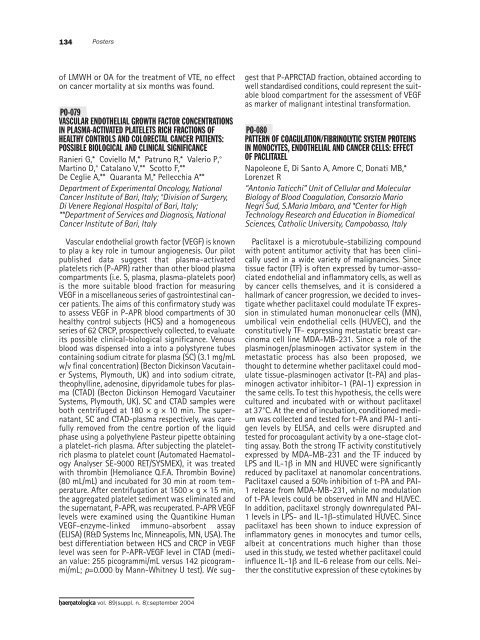Haematologica 2004;89: supplement no. 8 - Supplements ...
Haematologica 2004;89: supplement no. 8 - Supplements ...
Haematologica 2004;89: supplement no. 8 - Supplements ...
- No tags were found...
You also want an ePaper? Increase the reach of your titles
YUMPU automatically turns print PDFs into web optimized ePapers that Google loves.
134Postersof LMWH or OA for the treatment of VTE, <strong>no</strong> effecton cancer mortality at six months was found.PO-079VASCULAR ENDOTHELIAL GROWTH FACTOR CONCENTRATIONSIN PLASMA-ACTIVATED PLATELETS RICH FRACTIONS OFHEALTHY CONTROLS AND COLORECTAL CANCER PATIENTS:POSSIBLE BIOLOGICAL AND CLINICAL SIGNIFICANCERanieri G,* Coviello M,* Patru<strong>no</strong> R,* Valerio P,°Marti<strong>no</strong> D,° Catala<strong>no</strong> V,** Scotto F,**De Ceglie A,** Quaranta M,* Pellecchia A**Department of Experimental Oncology, NationalCancer Institute of Bari, Italy; °Division of Surgery,Di Venere Regional Hospital of Bari, Italy;**Department of Services and Diag<strong>no</strong>sis, NationalCancer Institute of Bari, ItalyVascular endothelial growth factor (VEGF) is k<strong>no</strong>wnto play a key role in tumour angiogenesis. Our pilotpublished data suggest that plasma-activatedplatelets rich (P-APR) rather than other blood plasmacompartments (i.e. S, plasma, plasma-platelets poor)is the more suitable blood fraction for measuringVEGF in a miscellaneous series of gastrointestinal cancerpatients. The aims of this confirmatory study wasto assess VEGF in P-APR blood compartments of 30healthy control subjects (HCS) and a homogeneousseries of 62 CRCP, prospectively collected, to evaluateits possible clinical-biological significance. Ve<strong>no</strong>usblood was dispensed into a into a polystyrene tubescontaining sodium citrate for plasma (SC) (3.1 mg/mLw/v final concentration) (Becton Dickinson VacutainerSystems, Plymouth, UK) and into sodium citrate,theophylline, ade<strong>no</strong>sine, dipyridamole tubes for plasma(CTAD) (Becton Dickinson Hemogard VacutainerSystems, Plymouth, UK). SC and CTAD samples wereboth centrifuged at 180 × g × 10 min. The supernatant,SC and CTAD-plasma respectively, was carefullyremoved from the centre portion of the liquidphase using a polyethylene Pasteur pipette obtaininga platelet-rich plasma. After subjecting the plateletrichplasma to platelet count (Automated HaematologyAnalyser SE-9000 RET/SYSMEX), it was treatedwith thrombin (Hemoliance Q.F.A. Thrombin Bovine)(80 mL/mL) and incubated for 30 min at room temperature.After centrifugation at 1500 × g × 15 min,the aggregated platelet sediment was eliminated andthe supernatant, P-APR, was recuperated. P-APR VEGFlevels were examined using the Quantikine HumanVEGF-enzyme-linked immu<strong>no</strong>-absorbent assay(ELISA) (R&D Systems Inc, Minneapolis, MN, USA). Thebest differentiation between HCS and CRCP in VEGFlevel was seen for P-APR-VEGF level in CTAD (medianvalue: 255 picogrammi/mL versus 142 picogrammi/mL;p=0.000 by Mann-Whitney U test). We suggestthat P-APRCTAD fraction, obtained according towell standardised conditions, could represent the suitableblood compartment for the assessment of VEGFas marker of malignant intestinal transformation.PO-080PATTERN OF COAGULATION/FIBRINOLYTIC SYSTEM PROTEINSIN MONOCYTES, ENDOTHELIAL AND CANCER CELLS: EFFECTOF PACLITAXELNapoleone E, Di Santo A, Amore C, Donati MB,*Lorenzet R“Antonio Taticchi” Unit of Cellular and MolecularBiology of Blood Coagulation, Consorzio MarioNegri Sud, S.Maria Imbaro, and *Center for HighTech<strong>no</strong>logy Research and Education in BiomedicalSciences, Catholic University, Campobasso, ItalyPaclitaxel is a microtubule-stabilizing compoundwith potent antitumor activity that has been clinicallyused in a wide variety of malignancies. Sincetissue factor (TF) is often expressed by tumor-associatedendothelial and inflammatory cells, as well asby cancer cells themselves, and it is considered ahallmark of cancer progression, we decided to investigatewhether paclitaxel could modulate TF expressionin stimulated human mo<strong>no</strong>nuclear cells (MN),umbilical vein endothelial cells (HUVEC), and theconstitutively TF- expressing metastatic breast carci<strong>no</strong>macell line MDA-MB-231. Since a role of theplasmi<strong>no</strong>gen/plasmi<strong>no</strong>gen activator system in themetastatic process has also been proposed, wethought to determine whether paclitaxel could modulatetissue-plasmi<strong>no</strong>gen activator (t-PA) and plasmi<strong>no</strong>genactivator inhibitor-1 (PAI-1) expression inthe same cells. To test this hypothesis, the cells werecultured and incubated with or without paclitaxelat 37°C. At the end of incubation, conditioned mediumwas collected and tested for t-PA and PAI-1 antigenlevels by ELISA, and cells were disrupted andtested for procoagulant activity by a one-stage clottingassay. Both the strong TF activity constitutivelyexpressed by MDA-MB-231 and the TF induced byLPS and IL-1β in MN and HUVEC were significantlyreduced by paclitaxel at na<strong>no</strong>molar concentrations.Paclitaxel caused a 50% inhibition of t-PA and PAI-1 release from MDA-MB-231, while <strong>no</strong> modulatio<strong>no</strong>f t-PA levels could be observed in MN and HUVEC.In addition, paclitaxel strongly downregulated PAI-1 levels in LPS- and IL-1β-stimulated HUVEC. Sincepaclitaxel has been shown to induce expression ofinflammatory genes in mo<strong>no</strong>cytes and tumor cells,albeit at concentrations much higher than thoseused in this study, we tested whether paclitaxel couldinfluence IL-1β and IL-6 release from our cells. Neitherthe constitutive expression of these cytokines byhaematologica vol. <strong>89</strong>(suppl. n. 8):september <strong>2004</strong>
















